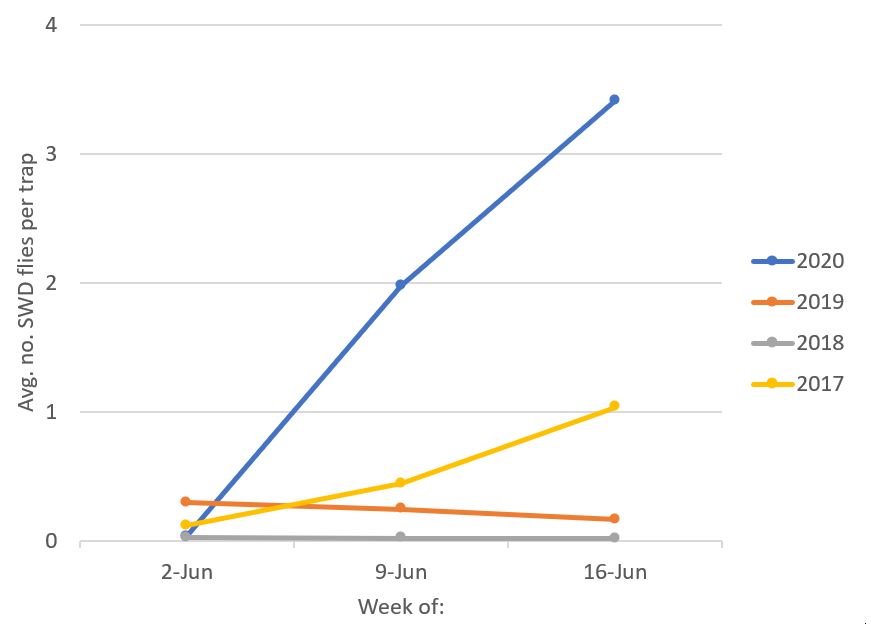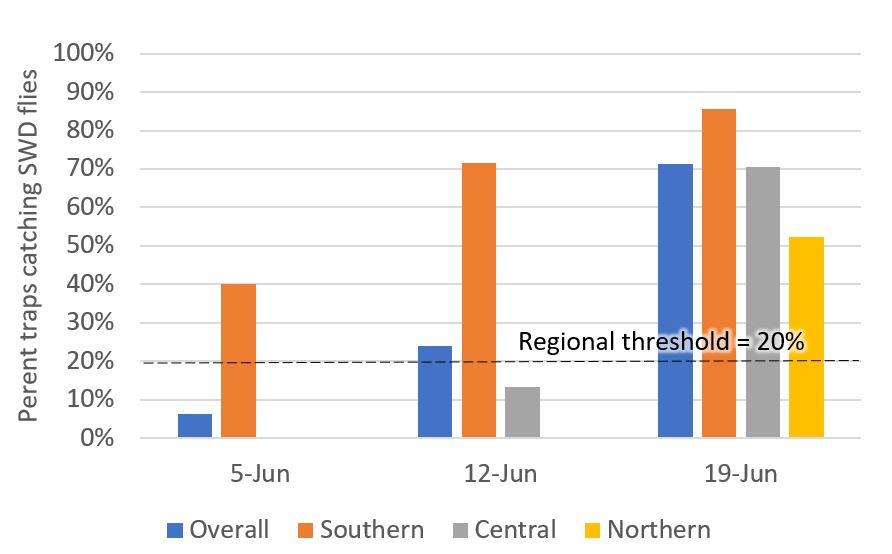Michigan spotted wing Drosophila update – June 23, 2020
Warm weather is here and SWD populations are rising. Expect to begin protecting susceptible crops.

For 2020, Michigan State University Extension will be monitoring for spotted wing Drosophila (SWD) in 17 counties at 91 sites that include vineyards, sweet and tart cherry orchards, and blueberry, raspberry, and strawberry plantings. This report is the first of the season and week three of our monitoring efforts. Of the 47 sites reporting this week, 71% of the traps have caught SWD. SWD has been caught in all of the following counties this season: Allegan, Antrim, Benzie, Berrien, Genesee, Grand Traverse, Kent, Leelanau, Livingston, Macomb, Manistee, Mason, Oceana, Ottawa and Van Buren.
Weather interactions
Weather is an important driver of SWD activity. Over the past few weeks, we have seen some flip flopping from week to week in terms of temperature and rainfall. Last week was warmer and drier than normal; over the weekend and Monday night, June 22, some areas got some rain. The increased rainfall and resulting humidity resulted in recent rapid SWD population growth compared with previous seasons (Figure 1), but it is mainly southern Michigan sites that are driving this trend.

Berries
Strawberries are being harvested across northwest, central and southern Michigan, and there have been some reports of SWD being active in and infesting strawberries in some areas. Blueberries and raspberries are not at a susceptible stage at this time. More on managing SWD in berry crops will be presented in two weeks during the SWD Friday webinar series on July 3.
Cherries
Crop loads in cherries are highly variable across the state. With fewer cherries on the trees, the expectation is that remaining cherries will be extremely vulnerable to attack. This is the first season that we are exploring the use of fruit phenology to help predict when cherries may be at low, medium or high risk of infestation by SWD. The following model output, which we are working towards validating during the 2020 field season, is based on the assumption that cherry ripening will occur between 954 to 1170 growing degree days (GDD) base 39.2 degrees Fahrenheit post bloom, and that SWD flies have been caught in the area. * indicates low risk, * indicates medium risk, and *** indicates high risk of fruit infestation by SWD. More about how to use this model will be presented during the SWD Friday webinar series on June 26.
|
Sweet cherry | |||
|---|---|---|---|
|
Weather station |
Bloom (biofix) |
Current risk for June 22 (GDD base 39.2 F since bloom) |
Forecasted risk for June 26 (GDD base 39.2 F since bloom) |
|
SWMREC |
1-May-20 |
1255*** |
1377*** |
|
Commerce TWP |
4-May-20 |
1102** |
1222*** |
|
Sparta |
7-May-20 |
1058** |
1168** |
|
Benzonia |
20-May-20 |
819* |
915* |
|
NWMHRC |
22-May-20 |
802* |
900* |
|
Elk Rapids |
22-May-20 |
762* |
858* |
|
Old Mission |
22-May-20 |
764* |
860* |
|
Williamsburg |
22-May-20 |
776* |
873* |
|
East Leland |
23-May-20 |
712* |
809* |
* = low risk
** = medium risk
*** = high risk
|
Tart cherry | |||
|---|---|---|---|
|
Weather station |
Bloom (biofix) |
Current risk for June 22 (GDD Base 39.2 F since bloom) |
Forecasted risk for June 26 (GDD Base 39.2 F since bloom) |
|
Commerce TWP |
10-May-20 |
1066** |
1187*** |
|
SWMREC |
12-May-20 |
1162** |
1284*** |
|
Hart |
17-May-20 |
929* |
1032** |
|
Benzonia |
24-May-20 |
721* |
817* |
|
East Leland |
25-May-20 |
666* |
763* |
|
Eastport |
25-May-20 |
684* |
784* |
|
Old Mission |
25-May-20 |
693* |
790* |
|
NWMHRC |
26-May-20 |
697* |
795* |
* = low risk
** = medium risk
*** = high risk
Grapes
Grapes are not at a susceptible stage anywhere in the state at this time. Details on how to manage SWD and other drosophilids to minimize their role in sour rot in grapes will be presented during the SWD Friday webinar series on Aug. 14.
Managing SWD
Given how quickly this pest can reproduce and how devastating infestation can be, if your crop is at a susceptible stage and you have begun to catch SWD flies in traps monitored on your farm – or if at least 20% of traps in your region have caught SWD flies in the past week (Figure 2) – a cover spray of an insecticide that is rated excellent against this pest should be applied to protect fruit and maintain populations at current low levels. Remember to rotate insecticide classes once you begin your spray program. Most of the crop-specific management guides have been updated for the 2020 season and are available as free downloadable PDFs here.
For more information on effective insecticides registered for use to control SWD, refer to the MSU Extension Michigan Fruit Management Guide for 2020 (E-154).

Sampling fruit for SWD infestation
Growers can determine how well their program is working by sampling fruit and using the salt test in the days prior to harvest. Details on fruit sampling methods and identifying SWD and other insects that can be found in berries and cherries will be presented during the SWD Friday webinar series on July 10.
Monitoring for SWD on your farm
The deli cup style trap is still the standard and can be used with either a commercial lure or a homemade yeast and sugar bait. For more information on how to monitor for SWD, refer to the crop management guides on the MSU IPM SWD webpage. For help with distinguishing SWD from all the other small flies that may be caught in SWD traps, refresh your ID skills with this factsheet: Spotted Wing Drosophila Identification Guide.
Counties being monitored in 2020
Allegan, Berrien, Genesee, Ingham, Livingston, Macomb and Van Buren in the south, Ionia, Kent, Mason, Oceana and Ottawa in central Michigan, and Antrim, Benzie, Grand Traverse, Leelanau and Manistee in the north.



 Print
Print Email
Email
